Pencil Cactus Care: How To Grow Euphorbia Tirucalli
I love Pencil Cactus and have grown one for many years. This is an easy plant to care for in the home and the garden. There are two key components of Pencil Cactus Care to keep it happy, healthy, and alive.
I’ve had my Pencil Cactus for a very long time now. It’s not the original plant, but a cutting I took in San Francisco, and it traveled with me when I moved to Santa Barbara. I brought a cutting of that plant when I moved to Tucson, so the lineage continues!
I first laid eyes on this plant when I was installing the Macy’s Spring Flower in the late 80’s, and it was part of one of the window displays. This was back before succulents became all the rage as they have been in the past fifteen years or so.
The show was full of rhododendrons, azaleas, hydrangeas, and the like. So, the Pencil Cactus turned my head. I ended up buying it when the show was taken down.
I’ve grown it as a houseplant and in the garden. Here’s what I’ve learned about this beautiful succulent.
Botanical name: Euphorbia tirucalli Common name: Pencil Cactus, Pencil Tree, Milk Tree, Pencil Plants, Indian Tree Spurge, Milk Bush
A popular variety of this plant is called “Sticks On Fire.” It doesn’t grow as large and has vibrant reddish/golden stems.
Note: This post was published on 11/4/2015. It was updated on 11/8/2023 with more info & new images.
Pencil Cactus Care Indoors
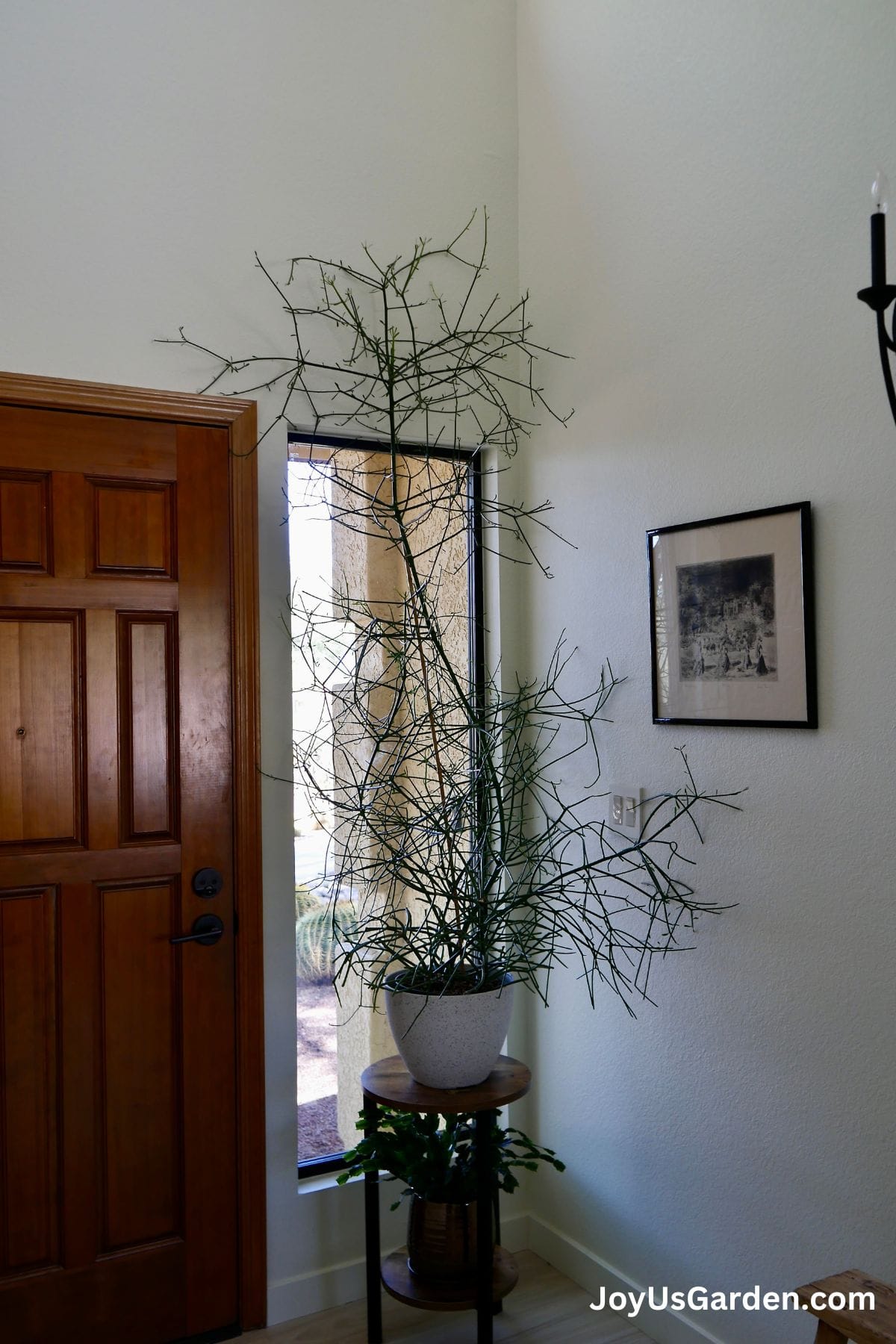
Size
Pencil Cactus grow bigger when living outdoors. Mine in the photo above is two years old, grows in a 10″ pot, and is 6′ tall x 2.5′ wide. I keep it pruned on the narrow side at the base so we can open the door!
Most Pencil Cacti I’ve seen sold in the indoor trade are in 6″, 8″, and 10″ grow pots. Their size ranges from 1′ to 5′.
The tallest I’ve seen one growing indoors is 9′. Mine will eventually get taller than that because it receives plenty of bright, natural light and has plenty of room to grow upwards, as the ceiling in my entryway is 13′.
Light Requirements
Pencil Cactus requires high light when growing indoors. It’ll need plenty of bright light to thrive. Place your Pencil Cactus in or near a west or south-facing window that receives at least 4-6 hours of direct sunlight daily. Just be sure it isn’t touching hot glass.
Mine grows in front of a tall, narrow south-facing window with another window at the top (not seen in the photo) and a picture window across the room, so it receives plenty of natural light all day.
You can tell if your Pencil Cactus is in light conditions that are too low if it starts to stretch out, lean towards the light source, or if the growth is looking weaker. If that happens, relocate it to a brighter area.
Rotate it every few months if it’s not getting enough light from all sides. This is especially true in the cooler months when the light will be less intense in your home.
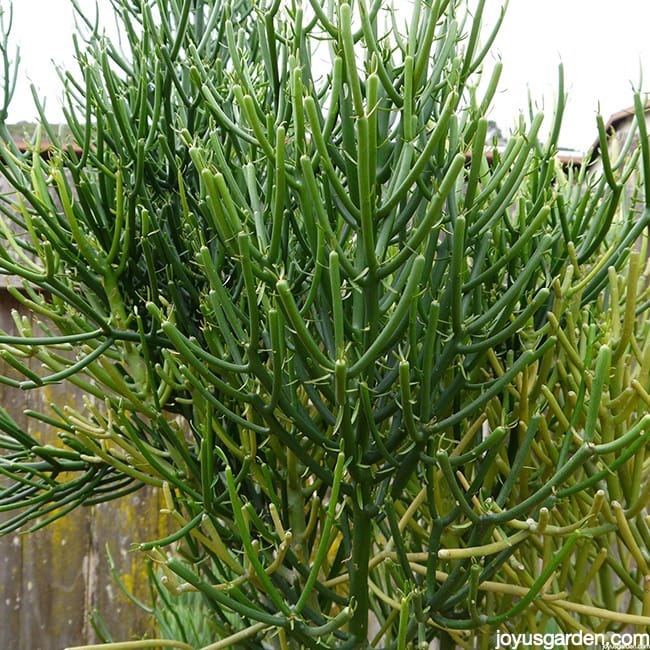
Water Requirements
Pencil Cactus is a succulent, so it’ll need less frequent watering than your tropical house plants.
In a nutshell, let the soil go dry before watering again. I water mine in a 10″ pot every two weeks in summer and every three to four weeks in winter.
Yours might need watering less or more often. Many variables come into play, like the pot size, the type of soil it’s planted in, its growing location, and your home’s environment. The more light and warmth, the more often yours will need watering.
If unsure, consider getting a moisture meter to monitor the soil dryness/wetness.
This post on watering succulents indoors will give you more information.
Temperature/Humidity
If your home is comfortable for you, it’ll be comfortable for your Pencil Cactus. It can tolerate our home temperatures and lack of humidity just fine.
To give you an idea of the extremes this plant can handle, mine growing outdoors in Tucson, AZ endures the 100F+ temps in summer and temperatures down to 28F in the winter.

Pencil Cactus Care Outdoors
Size
Pencil Cactus plants are native to Africa and, in their native environment, can grow to 30′, which is why they’re also called Pencil Tree.
As they mature, their branches flop and bend downwards as they grow. These plants can reach impressive heights in regions with a suitable climate; the tallest one I’ve seen was 15′ in the LA area.
Mine, growing in a pot in Santa Barbara, was around 6′ tall. You can see it pictured below. My newly repotted Pencil Cactus in Tucson is 8′ tall by 6′ wide.
Light Requirements
In Santa Barbara, zone 10b, my Pencil Cactus thrived in the late morning and afternoon sun. The mornings and late afternoons in summer were often foggy and cool, so full sun was fine.
In Tucson, zone 9a, where the summers are hot and intensely sunny, mine does best in bright shade. It receives morning sun for about an hour or two.
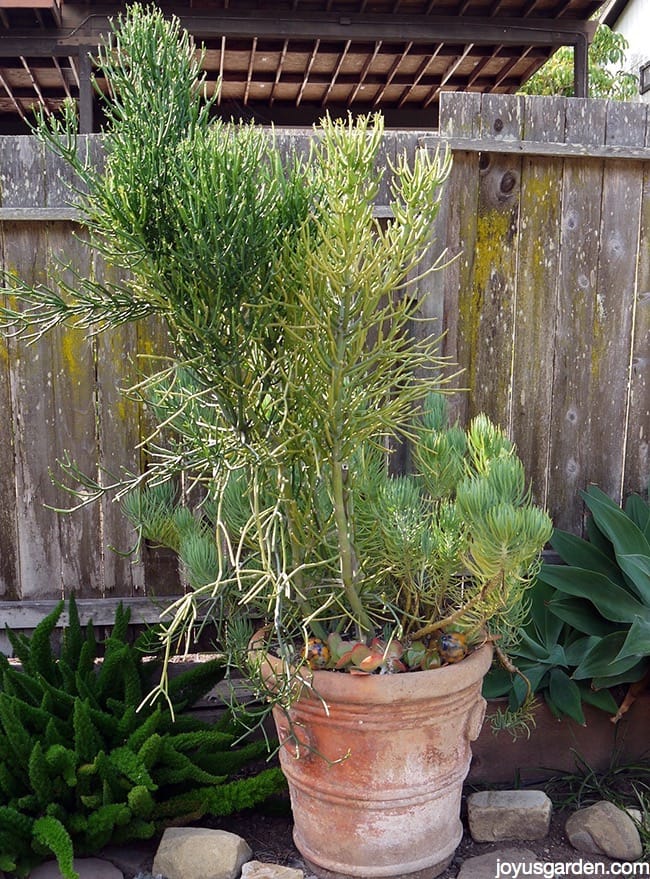
Water Requirements
With its succulent characteristics, the Pencil Cactus thrives in conditions with minimal water.
During the summer, when it’s growing season, infrequent but deep waterings are ideal. It ensures that the roots receive moisture, and the soil can dry out between watering sessions, preventing the risk of overwatering, which can be detrimental to these plants.
Mine grew in a large terra cotta pot measuring 28″ x 28″ in Santa Barbara. During the summer, I watered it every month or so, providing two big watering cans full at a time.
In Tucson, I was watering mine in an 18″ pot every 7-10 days in summer. It was just repotted into a 29″ x 29″ pot (badly needed!), so I imagine it’ll be every two weeks in summer.
The smaller the pot, the more often it’ll need watering.
I back off on the watering frequency in the winter months. How often depends on the temperatures and the rainfall.
If you want more details on this, check out how often should you water succulents.
General Pencil Cactus Care
Pencil Cactus Soil
Like other succulent plants, a Pencil Cactus must grow in a mix with good drainage and aeration. Using chunky or gritty soil specially formulated for cactus and succulents is best.
For years now, I’ve been making my succulent soil. You can find the DIY Succulent Soil Recipe here. My outdoor and indoor succulents grow well in this fast-draining mixture of coco chips, coir, and pumice.
If you don’t want to make your own, there are plenty of online sources to buy the mix. I’ve used Dr. Earth, EB Stone, Bonsai Jack, and Tanks’. Other popular choices are Superfly Bonsai, Cactus Cult, and Hoffman’s.
If you’re growing Pencil Cactus in a container, make sure that the pot has adequate drainage holes to allow excess water to escape. The build-up of too much water can quickly cause root rot; the water needs to drain out of the container it’s growing in.
If it’s in the ground, that might mean adding some loam to your soil or other material to add the drainage. You can check with your local landscape supply company to see what they provide.
Indoors: I always use straight succulent and cactus mix with some amendments (compost and worm compost) mixed in.
Outdoors: I used 3/4 succulent & cactus mix and 1/4 potting soil with amendments added in coastal Santa Barbara.
I recently used 1/2 succulent & cactus mix with 1/2 potting soil and added amendments in hot, dry Tucson, where I want the soil to hold more moisture.
The potting soils I use on the regular are Happy Frog and Ocean Forest.
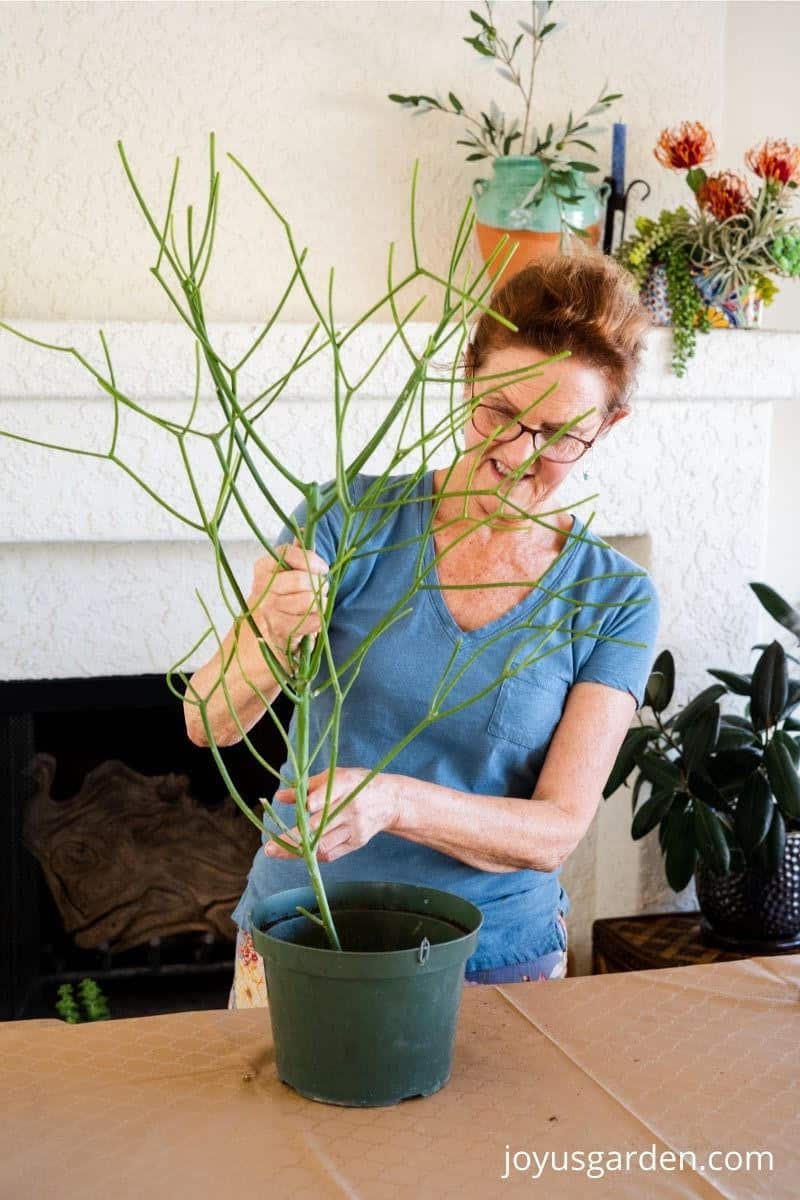
Repotting
The best time to repot a Pencil Cactus is during the growing season. That’s spring and summer into early fall.
Pencil Cactus, when small, don’t have an extensive root system. They’re happy to stay in the same pot for a while, but at some point, they’ll need to be transplanted into a new pot.
I repot mine when the plant is out of scale with the pot. Pencil Cactus get heavy as they grow and need a bigger base to support that. On average, I repot mine every four to seven years.
They get much harder to repot as they get larger because of the weight issue. When my large Pencil Cactus was repotted a month ago, I had three men doing the job. The plant was so heavy I couldn’t move it, let alone lift it into a 29″ pot!
Try not to break branches or stems when repotting this plant. Read the section on “Pencil Cactus Sap/Toxicity” below.
Here’s a general guide to repotting succulents, which you’ll find helpful.
Pencil Cactus Fertilizer
A Pencil Cactus isn’t fussy in this department. When planting, I feed mine with a worm compost/compost blend and top dress every two or three years in spring.
During the growing season is the best time to feed your Pencil Cactus. We have a long growing season here in Tucson from mid-February through October. I fertilize with Maxsea or Sea Grow, Grow Big, and Liquid Kelp five times during the growing season. I alternate using fertilizers and don’t mix them.
Whatever indoor plant food you choose, don’t over-fertilize because salts build up and can burn the plant’s roots. This will show up as brown spots on the stems.
Pencil Cactus Pruning
Spring and summer are the best times to prune a Pencil Cactus. Into early fall is fine also if you’re in a more temperate climate.
These plants grow fast when the conditions are to their liking. You might have to prune yours at some point to control the size, to shape it, or to propagate.
I haven’t pruned my large one growing outdoors lately because it has plenty of space to grow. I prune mine indoors twice a year to control the width.
If your plant is in a pot, you don’t want to prune too much off the base and leave most of the growth at the top. They get top-heavy, and your plant could take a tumble.
Learn more about Pencil Cactus pruning here!
Warning: Be very careful when pruning this plant. Read the section on “Pencil Cactus Sap/Toxicity” below.
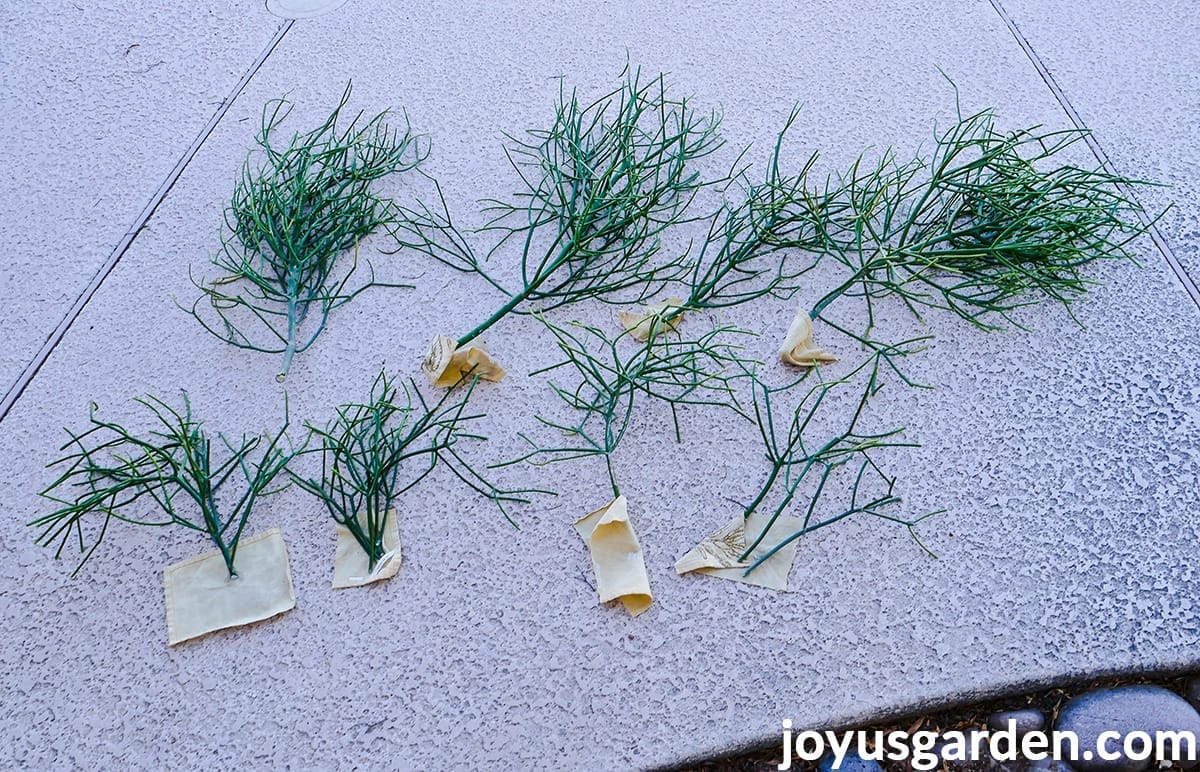
Pencil Cactus Sap / Pencil Cactus Toxicity
Some say the sap of this plant is overrated in regards to toxicity; others say it’s very toxic. I’ve been growing this plant for over thirty years and have had no issues. I wear gloves when pruning it and am very careful not to get it near my face, especially the eyes or mouth.
I have once or twice gotten a small amount of sap on my arm, which hasn’t irritated me. One of my readers shared that it was highly irritating to him, especially when exposed to the sun. Do some research, and come to your own conclusion.
These plants are considered to be toxic to humans and pets. I get my information on this subject from the ASPCA.
My cats pay no attention to my Pencil Cactus, but because of the sap, keep your eye on your pets around this plant.
When I’m pruning, especially indoors, I cover the cut ends on the stem and the plant to keep it from dripping onto the floors, furniture, or my clothes. It can leave black stains.
Pests
Pencil Cactus plants are tough cookies! Mine, or any I’ve seen, have had no pest issues.
Like most succulents, mealybugs are the number one pest. Also, keep your eyes open for aphids and spider mites, as they could be an issue.
For most pest infestations, you can control them with neem oil or insecticidal soap. The latter is what I’ve been using for two years now and has been effective.
Pencil Cactus Care Video Guide
Large Pencil Cactus Repotting Video Guide
Conclusion: Pencil Cacti are easy to grow if you give them two things: bright sunlight and water when the soil is dry.
These wacky yet wonderful plants are great for people who travel or tend to forget (not intentionally, I’m sure; we know how that goes) about their houseplants.
The far-out and fabulous-looking Pencil Cactus doesn’t like to be fussed over in the garden or your home!
Happy gardening,

This post may contain affiliate links, you can read our policies here.
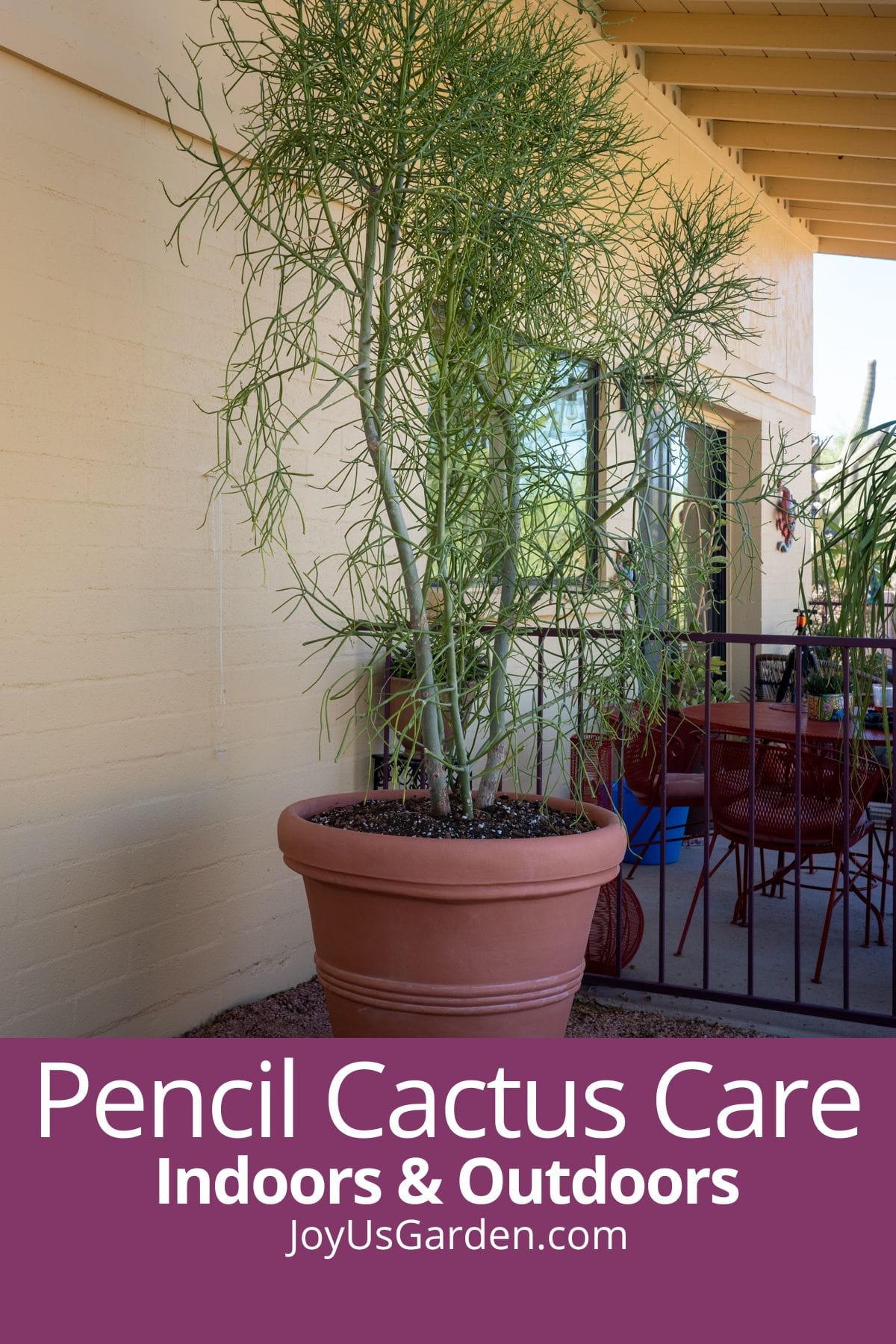
- About the Author
- Latest Posts
Nell, the founder of Joy Us garden, was born into a gardening family and grew up in Connecticut’s countryside. After living in Boston, New York, San Francisco, & Santa Barbara, she now calls the Arizona desert home. She studied horticulture & garden design, working in the field all her life. Nell is a gardener, designer, blogger, Youtube creator, & author. She’s been gardening for a very long time & wants to share what she’s learned with you.



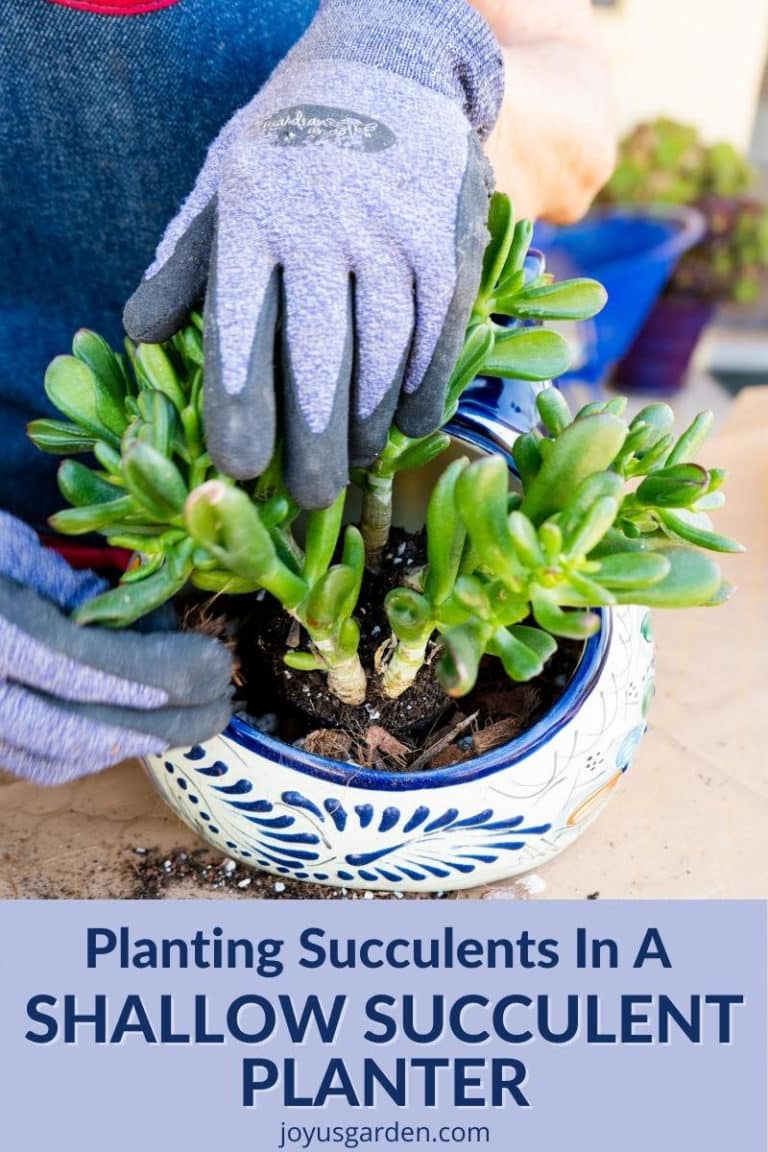
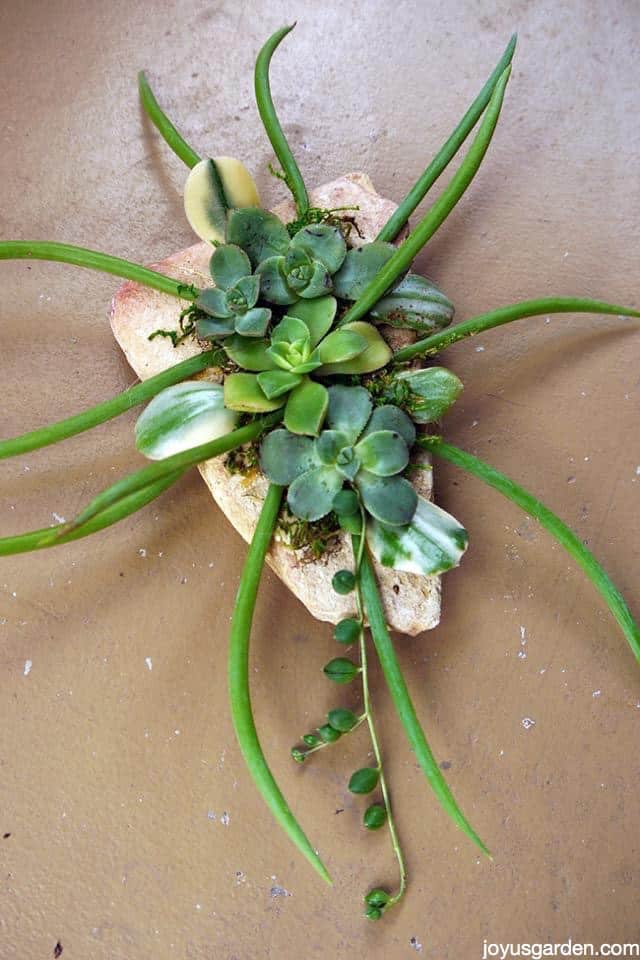
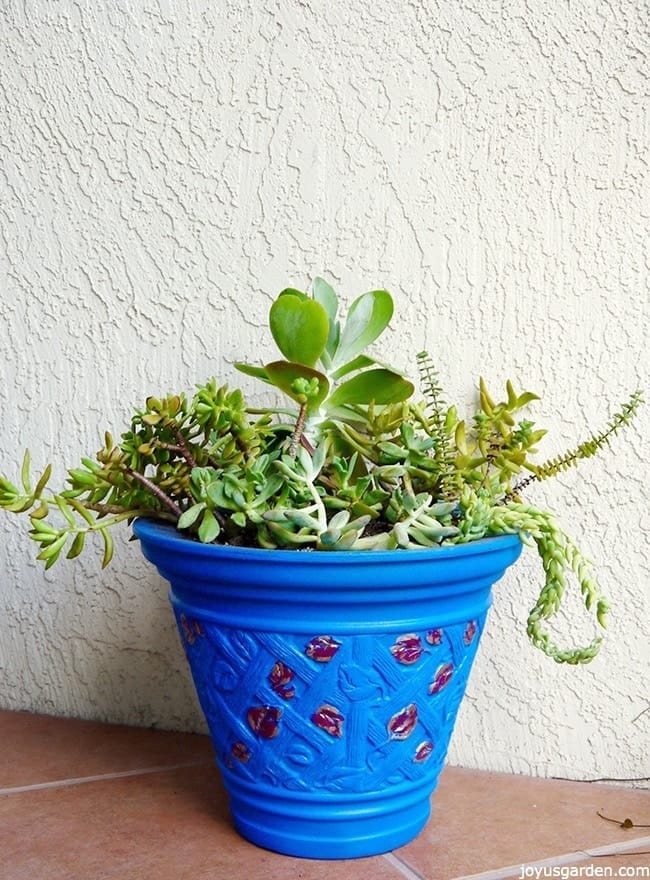
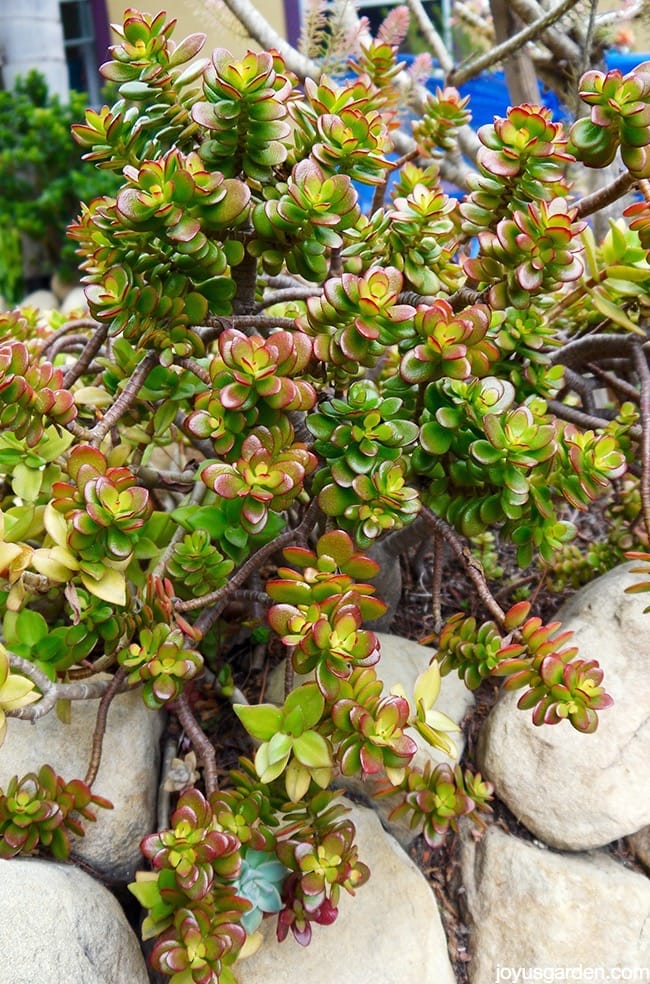

Nell, thanks for the write-up — I have a question about a pencil tree that I have in my backyard: It was transplanted about a year ago from a family that had it for about 15 years. It was basically bursting out the pot it was packed in and so when we received it, we decided to put it in the ground and OH MY! It grew about 3 feet (about 10 feet tall) and was probably the greenest thing in our yard. Sadly, while out of town, we had a good freeze that has seeminfly killed the trunk of the pencil tree. After a few months, I noticed no change. Today, I pulled it out of the ground, in hopes of transplanting it to a pot where I could more carefully take care of it.
NOW MY QUESTION: The roots are strong and moist and still showing signs of life, is it possible to save the tree with a healthy root system if the trunk itself seems to have died? Low to the base of the trunk I am still getting some of the white “goo” that pencil trees normally put off if their branches are cut.
Hi Brenda – I’ve never had that happen to a Pencil Cactus nor do I know anyone who has. I imagine that it would re sprout from the base of the stem or trunk if any is left. Nell
Thanks, Nell. Will give that a shot!
Great Brenda!
Hi Nell
Thanks so much for this informative video! My pencil cactus has some small brown patches on it with fuzz/ teeny hairs. Should I cut them off? The plant seems fine otherwise
Thank you!
Hi Ritika – You’re welcome! It’s sounds like some sort of fungus because of the fuzzy hairs. If it were just the brown spots, I’d say sun scald or some type of environmental damage. I’m not 100% sure it’s fungus so you can do a little research & check it out. Hope that helps, Nell
Hi! I just was given a very very large pencil cactus. It’s in a pot and is probably 10′ tall. It doesn’t appear to be top heavy as it is not dropping and appears very healthy. I’m wondering if I should repot it, or stick it in the ground. I live in South Florida, and my yard is full sun. Also, should I trim it at all to prevent it from getting top heavy?
Hi Alex – I’m not really familiar with South Florida gardening but I do know your soil is probably heavier & you get more rain than a Pencil Cactus prefers. I think it would be best to keep it a pot (bigger of course if needed) that way you can insure the water thoroughly drains out of the soil & it doesn’t get too wet. As for the trimming: I never tip pruned mine in Santa Barbara & it grew to be very strong. The cuttings I brought to Tucson grew so much I had to stake them up with a piece of cholla wood. That call is yours. Nell
Hi Nell:
I live in Maryland and purchased a pencil plant back in April and have had it outside on my deck ever since. Now that the temps have dropped (lately it’s been in the 40s and 50s but we had a few nights already where the temperature was freezing – below 20 degrees). I noticed that the plant has turned a whiteish-grey color entirely. I wish I could post pictures here to show you! I can’t find any information online if it’s dead or if I can bring inside to bring back to life and green again 🙂
Are you able to provide any advice on how to proceed? Do you think I should toss it or try to nurse it back to health again (if even an option)? I know handling these types of plants can be tricky with the poisonous white sap it emits if the branches are broken. Thank you!
Hi Lindsey-
When plants change color, it’s due to environmental stress. I’ve had a few stems turn whiteish-grey before they die but not the whole plant. If attacked by a fungus, they can also turn white. Those branches won’t turn green again. I’ve never had to do this but you can always try cutting it all the way back & see if it rejuvenates. Getting a new one might be the solution! Nell